ABSTRACT
An ethnobotanical survey was conducted to document medicinal plants commonly used for the treatment of women related diseases by the inhabitants of Akoko in Ondo-State, Nigeria. A total of 36 plants, belonging to 29 families were documented. The abundance status of the identified plants revealed that 24% of the plants were very abundant, 34% were abundant while 42% were scarce. Aframomum melegueta, Ageratunm conyzoides, Alchornea laxiflora, Allium sativum, Aspilia africana, Ananas comosus, Carica papaya were the most frequently mentioned plants. Most of the respondents found the plants to be effective (78%), 12.5% believed the plants as being highly effective while 8.5% believed that the plants were not effective as being reported. The factor of citation of plants ranged between 60 to 95, the plants were holistic in action, rarely toxic and or harmful. The diseases mentioned were veneral diseases, breast cancer, diabetes, pre and postnatal complications, infertility, menstrual disorder, vaginal discharge and fibroids.
Key words: Medicinal plants, diseases, women, abundance, biomedicine, frequency of citation,
Medicinal plants are now recognized worldwide, both by the rural population and urban elite as an important healthcare resource especially for women. Ezeigbo (1996) observed that most Nigerian women labored under stress because they are over whelmed by the responsibilities of their homes and the society in order to sustain their traditional roles in the family effectively. She noted that the peace and stability of homes depend largely on the managerial abilities of women folks. She stressed further that women especially the mothers plan, organize, direct and coordinate all the resources of the home. Apart from their numerical strength, women have great potentials necessary to evolve a new economic in order to accelerate social and political development and consequently transformed the society into a better one (Awe, 1990),
In Nigeria, women are subjected to social, cultural, physical and mental disorders that constituted health hazards for them. A study revealed that 1 out of every 15 African women died from complications of pregnancy, breast cancer, fibroid, diabetes, pre and postnatal care (Abudoulaye et al., 2006). Plants, with their curative values possess the potentials to ameliorate the situation (Akinnibosun and Odiete, 2008; Olanipekun et al., 2013). Nigeria is endowed with diversity of plants and animals that are naturally used as foods, medicine and for clothing and shelter (Odugbemi and Akinsulire, 2006). Plants in particular, have been a major source of medicine for human kind. Although the traditional importance of plants as medicine has been ignored in the time past by many biomedical practitioners because the clarity of the chemical composition, dosages and toxicity level of plants used in ethnomedicine is not clearly defined (Lowel et al., 2001; Balick and Cox, 1996). However, recent initiatives revealed that many resistance developed by disease causing organisms against synthetic drugs are now been overcome through the use of medicinal plants; hence there seems to be a drastic shift of some people from orthodox drugs to herbal products in curing ailments.
The re-emergence of interest in the use of medicinal plants as a solution to health problems has been fuelled by the rising cost of synthetic drugs in the maintenance of personal health as well as the ineffectiveness of some of the synthetic drugs because of the resistance developed against them by some disease causing organisms (Zucker and Campbell, 1992; Sharma, 1997). The documentation and conservation of the available species used in the treatment of diseases is always a good step in good directions. The main objective of this study therefore, is to document plants used in treating women health challenges with a view of identifing how they are used and the level of abundance of the plants in Akoko Region, Ondo-State, Nigeria.
Study area
The study was conducted in Akoko South Local Government Area (LGA) of Ondo State. The LGA is made up of four communities namely; Iwaro Oka, Ayegunle Oka, Sumerin Oka and Oba Akoko; it is located within latitude 4.600N and longitude 3.300E. It is bounded in the East by Epinmi and Ipe , in the West by Akungba and Supare, in the North by Ise Iboropa and Ugbe Akoko, while in the South by Oba and Ikun towns. It covers an area of thirty square kilometers and the vegetation is derived from savanna with scattered forests all over the area. The climate of Oka land is equally determined by Southwest Monsoon Winds and North east wind. It has a mean annual rainfall of about 1,270 mm and annual temperature of over 21oC. Humidity is relatively high for about eight months of the year. The inhabitants are predominantly farmers, engaging in subsistence farming. The major agricultural products from the study area are cassava, palm oil and cola nut.
METHODS OF DATA COLLECTION
An open-ended semi-structured questionnaire was utilized in obtaining information on plants used in the treatment of diseases affecting women in the study area. Interviews were conducted with a fairly open framework that allowed for focused, conversational and two-way communication as suggested by Kayode et al. (2009). A total number of 80 respondents were interviewed. The respondents consisted of men and women particularly herb sellers, community leaders and traditional healers. Secondary Information was also gathered from key informants who included officials from the Ministry of Health, hospitals and other stakeholders. These officials also helped to validate the scientific names of the diseases.
The information collected on the plants was properly documented. Information gathered included diseases affecting women, the name of plants used to cure the diseases, parts of the plants used, methods of preparations and mode of administration. The vouchers specimens of the identified plants were collected and taken to the herbarium of the Department of Plant Science, Ekiti State University, Ado-Ekiti for identification and authentication. Also the abundance status of the plants species was determined using the time taken to physically come in contract with the samples of the plants by the respondents in the communities (Kayode et al., 2015). The samples that were sighted within 20 min walk from the centre of the community were regarded as very abundant, abundant when sighted within 30 to 60 min but scarce when it takes more than 60 min to be sighted.
The frequency of citation (Fc) of the species which specifies the fidelity level of awareness and the usage of the species among the respondents was determined according to Kayode et al. (2015) using the formula:
Fc =Nr × 100/N
Where Nr =The number of respondents that mentioned the species. N =The total number of respondents interviewed
The results obtained revealed that a total of 36 plants species belonging to 29 families are used in the treatment of women diseases in the study area. The parts of the plant used included roots, stems, leaves and stem barks (Table 1). These plants were used in treating various diseases affecting women in the study area. The respondents were observed to possess immense knowledge on the medicinal values of the species. The use and effectiveness of the various parts of the plants is an indication that the bioactive ingredients that are responsible for their activeness are distributed in different parts of the plants. Olanipekun et al. (2013) reported the different bioactive ingredients such as alkaloids, saponins, tannins, cardiac glycoside as natural agents responsible for the effectiveness of some of the identified plants.
It was also observed that most of the plants (72%) were not cultivated; they were wild. Examples of the wild plant species were Aframomum melegueta, Ageratum conizoides, Alchornia laxiflora, Allium ascalonium, Aspilia africana etc. The remaining plant species (28%) were cultivated for various purposes other than medicinal. These included Ananas comosus, Carica papaya etc. The cultivation of plants ensures its availability and sustainability. Fruits of Ananas comosus and Carica papaya are good sources of essential micronutrients and needed anti-oxidants for the good performance of the body and improve the immune system. Data on the abundance status of the plants (Table 1) showed that 24% of the plants were very abundant. They are readily available because it does not take up to 20 s to come across them when needed. Also, the plants are cultivated because there are other purposes other than medicine they are used for (Table 1). However, 35 % of the plants were abundant, taking about twenty minutes journey before one could come across the plants. The population of these plants has started dwindled.

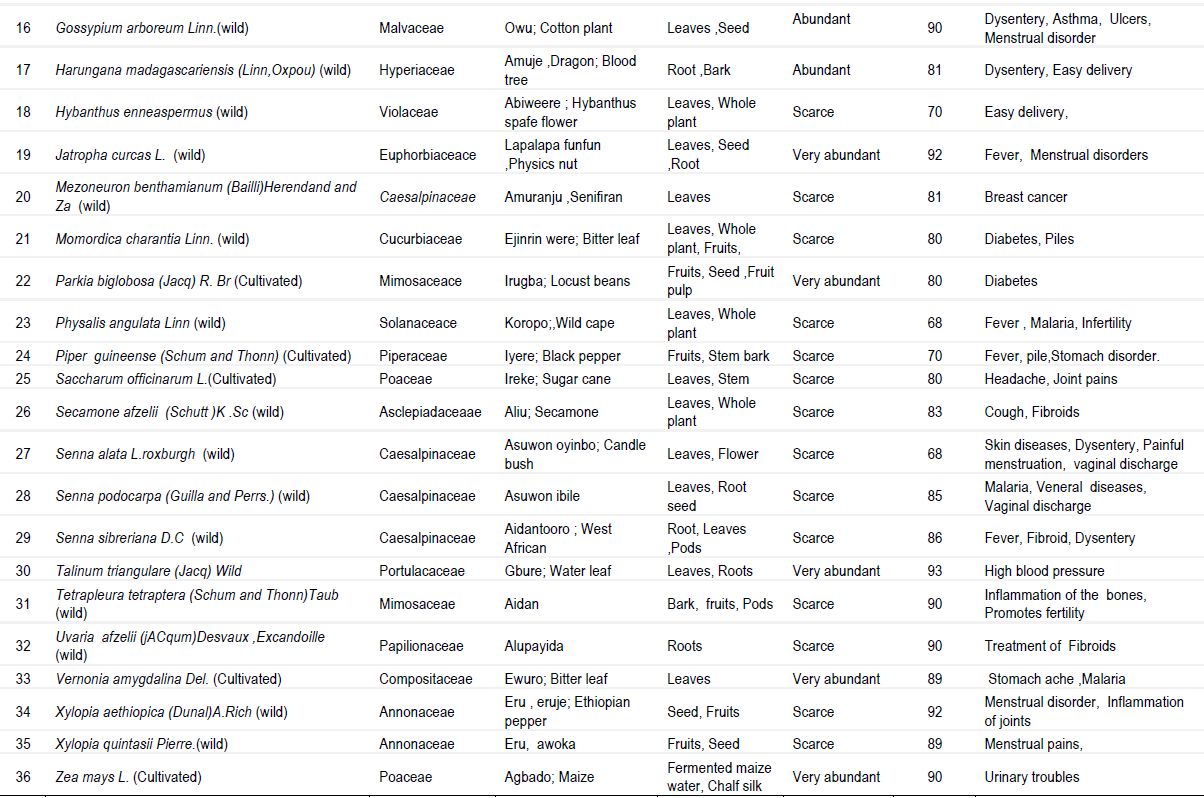
About 41 % of the plants were scarce and difficult to discover. Some of them take up to two to five days or more journey before coming across them. This could be as a result of pressure on the natural forest. Natural forest that is the home of many plants is now been converted and used for other purposes such as building, industries and road construction. Therefore, it is important to embark on extensive conservation and massive cultivation of the rare species from extinction (Table 3). The primary importance of the identified plants ranges from ornamental, shade, grains as food, leaves as vegetables, erosion control etc. The use as medicine is the secondary purpose (Table 4). The respondents’ frequency of citation of the identified species ranged between 60 and 95 (Table 1). This tends to suggest that the level of awareness, importance and acceptability of the medicinal species was high among the respondents (Kayode et al., 2015).
Details of plants preparations and mode of administration for the treatment of the diseases peculiar to women in the study area are shown in Table 2. Roots and the leaves of the plants, such as Senna podocarpa, Senna alata, Allium ascalonium were used collectively for the treatment of vaginal discharge and to treat menstrual disorder conditions. The treatment for pre and post natal care is also included. Plants such as Annona senegalensis, Aframomum melegueta, Hybanthus enneaspermus, Piper guineense were reportedly used as plants used to easy difficult labor and infertility in women . Plants used for the treatment of breast cancer include Cola acuminata fruits. The traditional use of plants in treating ailments by the rural dwellers is a common practice that has been used and found effective even when the use of orthodox has failed. It was reported by Yakubu et al., (2007) in an Ethnobotanical survey where it was revealed several reasons for using medicinal plants in the management of diseases in Nigeria.
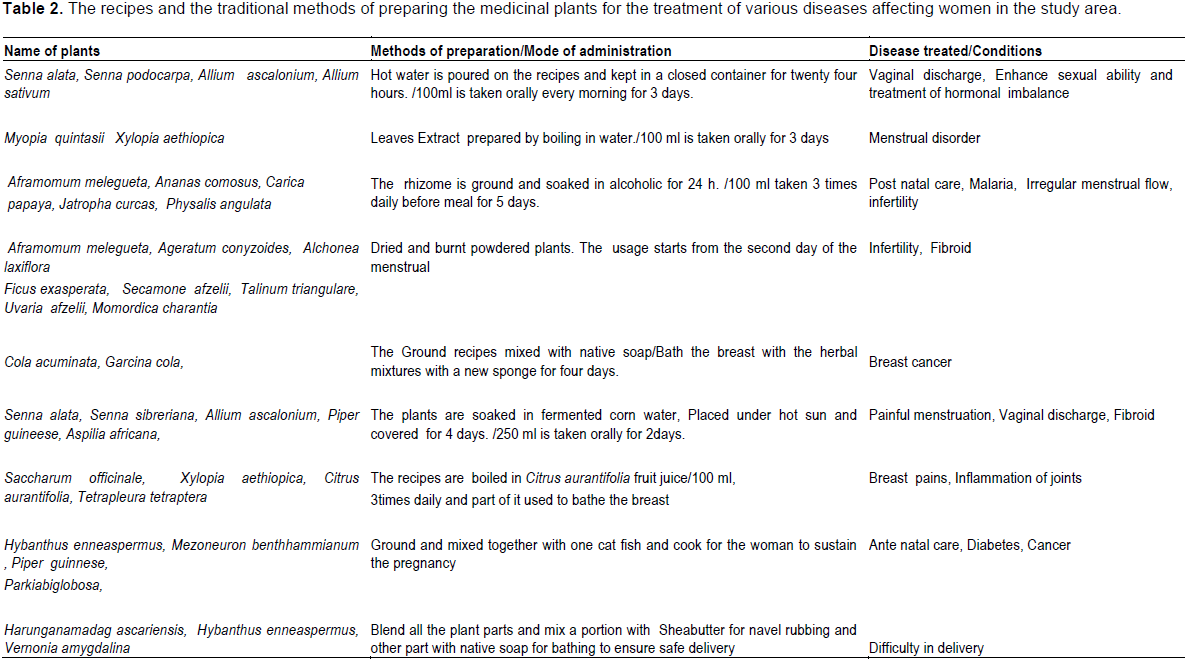
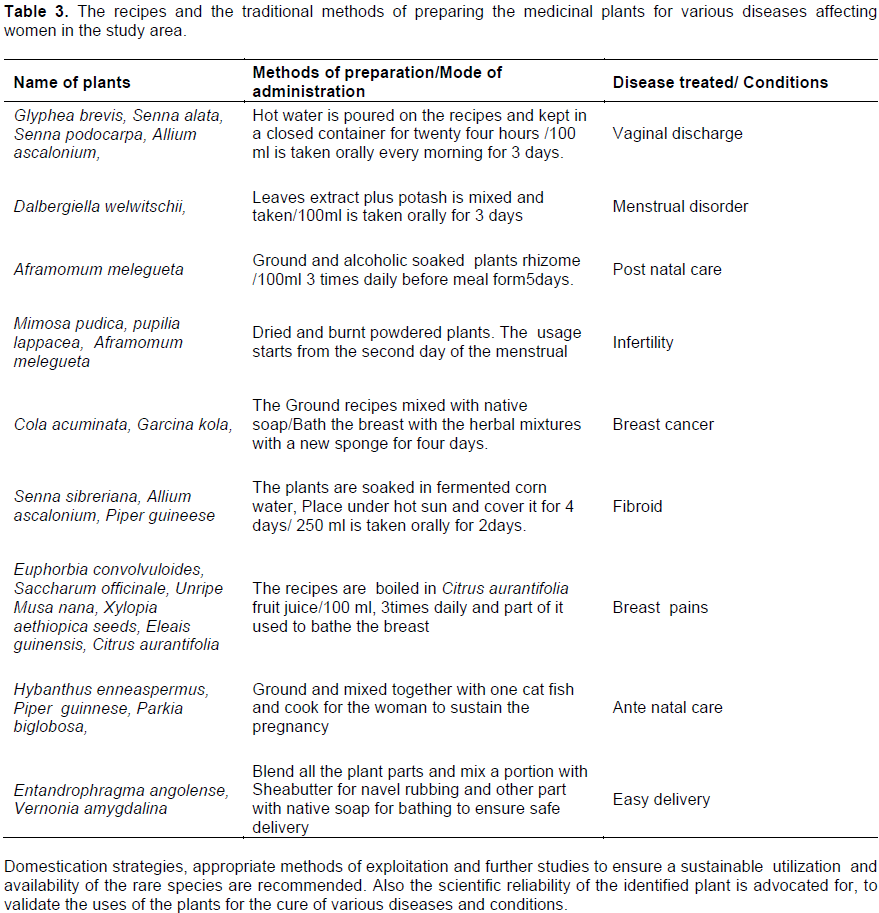
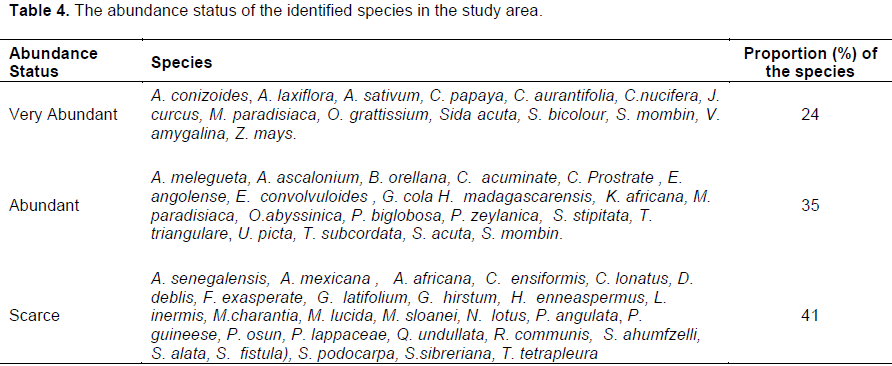
The incidence of various diseases affecting women in the study area has led to the use of orthodox medicine but unfortunately, the options are expensive, not easily available and with a lot of adverse effect. However, the respondents (78%) perceived the plants as being effective, while 12.5% of the respondents observed the treatments as being highly effective and it cannot be compared to the use of orthodox medicine (Table 5). Similarly, Ariba et al. (2007) reported that42.3% of the 79 Nigerian clinicians agreed that many patients preferred native medication to modern drugs. The study areas was urban-rural, the respondents have the traditional knowledge of preparing plants and need not skilled personnel for its preparation. The respondents have gathered experience through trial and error over several years. They observed plants as highly effective, holistic in action, rarely toxic or harmful.
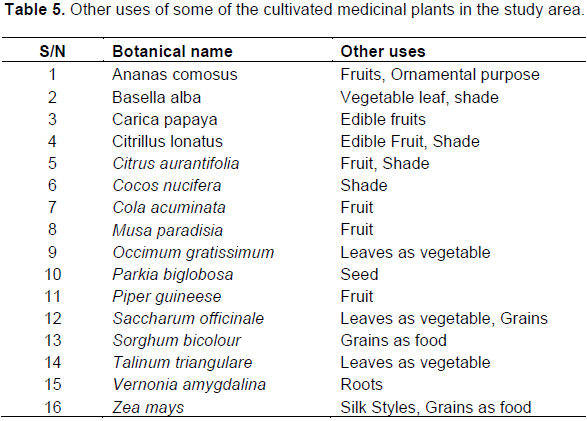
Also, plants have few or no side effect, readily available, easier to obtain, cheaper (Tables 6 and 7) and cure permanently than orthodox medicine and could save the nation huge foreign exchange that can be converted for other uses which will help in further national development (Arowosegbe et al., 2015, Kayode et al; 2015; Lewis, 2003 and Olapade, 2002).
The results obtained revealed that the study area consisted of various plant species suitable as medicinal remedies for the treatment of various health challenges affecting women in the study area. The frequency of citation indicated that the use of these plants is reliable, effective and culturally acceptable. However, plants are not abundantly available as expected to sustain the needs of the users, hence conservation measures are inevitable.
Domestication strategies, appropriate methods of exploitation and further studies to ensure a sustainable utilization and availability of the rare species are recommended. Also the scientific reliability of the identified plant is advocated for, to validate the uses of the plants for the cure of various diseases and conditions.
The authors have not declared any conflict of interests.
REFERENCES
|
Akinnibosun HA, Odiete W (2008). Baseline environmental studies of floristic diversity in a proposed crude oil exploration field in Edo State, Nigeria. Plant Arch. 8(2):551-556.
|
|
|
|
Ariba AJ, Oladapo OT, Iyaniwura CA, Dada OA (2007). Management of erectile dysfunction: perceptions and practices of Nigerian primary care clinicians. S. Afr. Fam. Pract. 49(9):16a-16d.
Crossref
|
|
|
|
|
Arowosegbe S, Olanipekun MK, Kayode J (2015). Ethnobotanical survey of medicinal plants used for the treatment of Diabetes mellitus in Ekiti-State Senatorial districts, Nigeria. Eur. J. Bot. Plant Sci. Phytol. 2(4):1-8.
|
|
|
|
|
Awe B (1990). The role of women in management in the 90s. J. Manag. Niger. 26(6):9-13.
|
|
|
|
|
Balick MJ, Cox PA (1996). Plants, people, and culture: The science of ethnobotany. Scientific American Library, New York, pp. 17-53.
|
|
|
|
|
Ezeigbo TA (1996). Gender Issues in Nigeria a Feminine Perspective. Lagos, Vista Books Ltd.
|
|
|
|
|
Kayode J, Olanipekun MK, Tedela PO (2009). Medicobotanicals studies in relation to veterinary in Ekiti-State, Nigeria Conservation of botanicals used for the treatment of poultry diseases. Ethnobot. Leaf. 13:273-280.
|
|
|
|
|
Kayode J, Michael AO, Modupe JA, Ayodele AO (2015). Stem Barks and Roots Extravitism in Ekiti State Nigeria: Need for Conservation as a Sustainable Innovation in Healthcare Management in Rural Areas. Am. J. Biosci. 3(2):28-33.
Crossref
|
|
|
|
|
Lewis WH (2003). Pharmaceutical discoveries based on ethnomedicinal plants: 1985 to 2000 and beyond. Econ. Bot. 57(1):126-134.
Crossref
|
|
|
|
|
Lowe H, Payne-Jackson A, Beckstrom-Sternberg SM, Duke JA (2001). Jamaica's Ethnomedicine: Its potential in the healthcare system. Pelican Publishers, Jamaica.
|
|
|
|
|
Odugbemi A, Akinsulire O (2006). Medicinal plants of Species Names. University of Lagos. Am. J. Plant Sci. 5(21).
|
|
|
|
|
Olapade EO (2002). The herbs for good health: The 50th anniversary lecture of the University of Ibadan (Vol. 3). NARL Specialist Clinic.
|
|
|
|
|
Olanipekun MK, Kayode J, Akinyemi MO (2013). Ethnoveterinary survey and proximate analysis of plants used in managing Newcastle disease of poultry animals in Ekiti State, Southwestern, Nigeria. Bull. Pure Appl. Sci. 32(1):29-33.
|
|
|
|
|
Sharma VP (1997). Drug resistance: Mechanism and management. In: Singhal RL, Sood OP (eds.), New Delhi: Ranbaxy science Foundation, India. pp. 67-72.
|
|
|
|
|
Yakubu MT, Akani MA, Oladiji AT (2007). Male sexual dysfunction and methods used in assessing medicinal plants with aphrodisiac potentials. Pharm. Rev. 1:49-56.
|
|
|
|
|
Zucker JR, Campbell CC (1992). Smear negative cerebral malaria due to mefloquin resistant P. falciparum acquired in the Amazon. J. Infect. Dis. 166(6):1458-1459.
Crossref
|
|